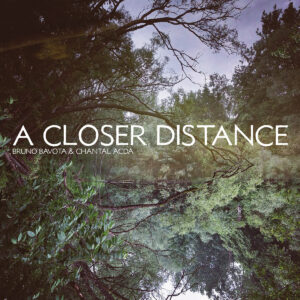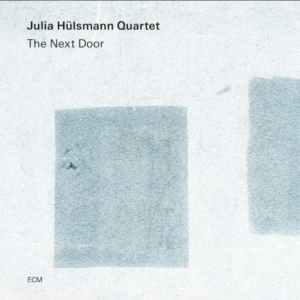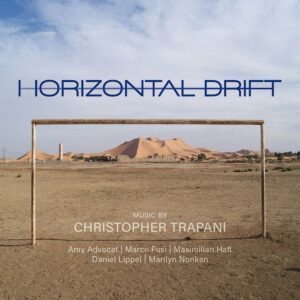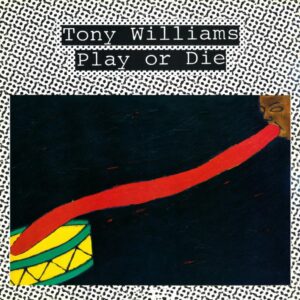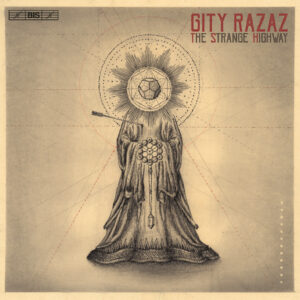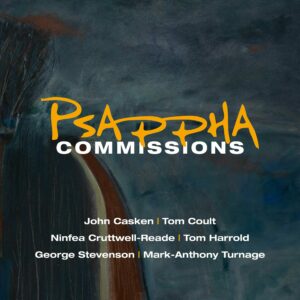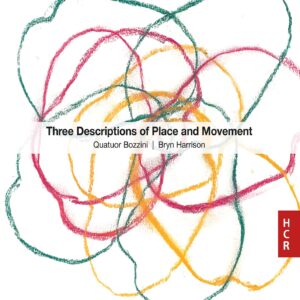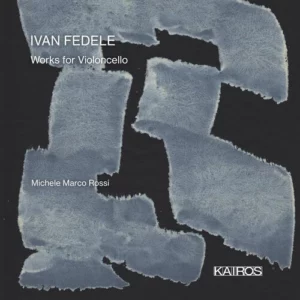Duo Bruno Bavota and Chantal Acda have released a teaser track from their forthcoming album, “A Closer Distance” (Temporary Residence). The recording is out on October 7th. In the meantime, one can revel in Acda’s gentle singing of short phrases and keening overdubs alongside Bavota’s post-minimal arpeggiations. They are a well-suited musical pair.
Julia Hülsmann Quartet
The Next Door
Julia Hülsmann, piano; Uli Kemperdorff, tenor saxophone; Marc Muellbauer, double bass; Heinrich Köbberling, drums
ECM Records
Since their 2019 debut recording, Not Far From Here, the Julia Hülsmann Quartet has spent a lot of time touring and gigging, refining their sound and improvisational aesthetic. The group’s latest recording, The Next Door, is primarily comprised of originals by quartet members, alongside a scintillating rock cover. The addition of tenor saxophonist Uli Kemperdorff to Hülsmann’s long standing trio with bassist Marc Muellbauer and drummer Heinrich Köbberling has been a winning choice. Kemperdorff’s florid runs contain a sunniness that buoys the musical atmosphere. Muellbauer often finds voicing for bass lines that eschew roots in favor of higher overtones, allowing his playing to blend with the chordal choices made by Hülsmann. Köbberling’s gifts are versatile. He knows when to press the players forward and instead to focus on fills and syncopation.
The album opens with “Empty Hands,” in which polymetric chordal planing in the piano is abetted first by a bass solo and then doubled melody with Kemperdorff. Hülsmann then plays a solo with undulating twists and turns and a change of mode midway. Kemperdorff’s solo turn is also filled with arpeggiation at rapid speed. Köbberling begins to assert himself in the last few choruses of saxophone soloing, which is followed once again by a doubling of the head, a bit more ornamented and ended without a button (a welcome way and underutilized way to stop).
“Made of Wood” is a standout track. Beginning with a saxophone solo, the head appears afterwards, once again doubled by saxophone and piano, a texture that the group takes as formative. Muellbauer and Köbberling work in an offsetted way against the melody instruments, finding holes for fills and bass riffs between phrase barriers. Hülsmann plays a lithe single-line solo which gradually is embellished with chromatic harmonies. Kemperdorff’s second solo turn is abbreviated in favor of a duet with Hülsmann. A brief denouement closes the tune.
“Wasp at the Window” features a multi-stop bass solo with percussive slaps to open. Kemperdorff then plays moto perpetuo scales that give us the dangerous little insect in motion. Hülsmann provides the wasp with a bit more of a swinging, jaunty swagger and the intricacies of the group’s rhythmic palette suggest the way the guest might nervously be perceived. It is a charming use of programmatic playing. “Jetz Nocht Nicht” is a set of imitative duets between saxophone and piano that could are an appealing but knotty musical puzzle. There is a reprise later in which the entire quartet gets to add their own strands to the counterpoint.
Hülsmann contributes five compositions to The Next Door, and shares writing duties with other members of the quartet. “Lightcap” is by Köbberling, and is a reference to the bassist Chris Lightcap, with whom the drummer played in the nineties. Kemperdorff plays a rangy and fiery solo over wide spaced changes. Köbberling shifts the underlying pulsation several times, asserting himself in his own piece. The last section is a funky outro that, as before, avoids punctuation at its close. “Post Post Post,” the drummer’s other composition, has an ambling melody that appears in various incarnations throughout the group’s haunting improvisations.
Kemperdorff’s “Open Up” is a hard swinging tune with bent notes and a sturdy harmonic background that gives Hülsmann plenty of room for substitutions. The rhythm section revels in playing in this trad-mod context. Both saxophone and piano solos are expressive and virtuosic in technical demands. Octave lines shared between piano, saxophone, and bass open “Polychrome,” a Muellbauer composition, which are followed by a pensive piano interlude that takes as much from Webern as from post-bop. Kemperdorff plays with extended scales that encompass the fully chromatic in several different patternings. Muellbauer provides grounding to this fiendishly difficult progression.
Hülsmann frequently uses water imagery, and “Fluid” takes the idea of a crescendoing arc, topped by waves of melody, as the formal design for this affecting ballad. When the pianist takes her solo, we move from the motile water music to equally lithe but swinging music for the quartet. Scalar passages bring back the sense of water’s flow, followed by cascading runs by Kemperdorff that also draw fluid to mind.” A final section of flowing arpeggios and muscular drums brings the piece to a close. Muellbauer makes a clever amalgam in the bossa nova “Valdemossa,” combining the traditional dance’s gestures with the chord progression from Chopin’s enigmatic Prelude in E-minor. The combination works beautifully, with Hülsmann leading in to her neoclassical side while Kemperdorff underscores tango rhythms in his solo turn.
A pop cover is often found on Hülsmann’s recordings. Here it is Prince’s “Sometimes it Snows in April.” It first appeared on Under the Red Cherry Tree, and the song’s long intro and quirky harmonic shifts are reflected in the quartet’s faithful and affecting recording. The Next Door shows a group that has developed its sound exploring different musical pathways with authority. Recommended.
-Christian Carey
Christopher Trapani
Horizontal Drift
New Focus Records
Christopher Trapani’s latest portrait recording for New Focus features pieces for solo instruments, several with electronics. The composer’s work with microtones and hybrid tuning systems is spotlighted. Trapani has a compendious knowledge of microtonality, and he brings it to bear eloquently in the programmed pieces.
The album’s opener, Târgul, is written for vioara cu goarna, a Romanian variant on the stroh violin, a violin with an added horn to provide greater projection. It also can provide fascinating timbres, as Maximilian Haft’s performance illuminates. Dan Lippel plays the title track on quarter tone guitar, abetted by real time electronics edited by a Max patch. It is a standout piece, with sinuous passages of quarter tones and glissandos followed and morphed by electronics. The use of complex arpeggiations is riveting.
Linear A is performed by clarinetist Amy Advocat. It uses still another tuning, the Bohlen-Pierce scale, which repeats at the twelfth instead of the octave. The electronics provide clarinet duets that make the already surreal environment of the scale enhanced by buzzing overtones. Lots of florid playing, which Advocat executes with aplomb.
Lost Time Triptych is an amalgam of influences. Written as a companion piece for Gerard Grisey’s Vox Temporum, it has three detuned pitches that play a pivotal role in the music. Each of the Triptych’s movements is subtitled with a phrase from Bob Dylan. Marilyn Nonken plays the piece with detailed balancing of its intricate harmonies and supple dynamic shading. Forty-Nine, Forty-Nine is for a 31-tone equal tempered Fokker organ that is controlled by MIDI rather than an organist. With a feisty analog demeanor,
it is reminiscent of some of the electronic pieces from the Columbia-Princeton Center,
The recording closes with Tessaræ, a piece written for the viola d’amore. This instrument has sympathetic strings, and Trapani deploys it to emulate folk music from Turkey and India that also has instruments with sympathetic strings. The viola d’amore’s capacities for harmonics and drones are set against a mournful mid-register melody. It is an affecting work that demonstrates Trapani’s capacity for emotional writing as well as technical innovation. Marco Fusi plays with a strongly delineated sense of the counterpoint employed in the piece.
Horizontal Drift is a compelling recording, demonstrating Trapani’s craft and imagination in equal abundance. Recommended.
Tony Williams
Play or Die
Tony Williams, drums, percussion, vocals; Tom Grant, keyboards, synthesizer;
Patrick O’Hearn, electric bass.
M.I.G. Music GMBH
Recorded in Stuttgart in 1980 and limited to 500 copies that weren’t widely distributed outside Germany, Play or Die, led by late drummer Tony Williams, is a unicorn record that is finally receiving a reissue. Joined by keyboardist Tom Grant and bassist Patrick O’Hearn, Williams leans in on one his most fusion focused recordings. Sharing the composition duties with O’Hearn, Play or Die includes two originals by the drummer, one by the bassist, and a “Jam Tune” credited to the trio.
O’Hearn’s contribution, “The Big Man,” features a low-range and wide-ranging melody on the bass guitar, one that could well stand beside “Walking on the Moon” as a memorable bass hook. Meanwhile, Tom Grant supplies ska chord stabs and synth filigrees and Williams goes his own way, playing powerfully with myriad virtuoso fills.
Williams begins “Beach Ball Tango” with a roll-filled solo. When the others join, O’Hearn once again provides a tuneful melody, but it is Grant who leads the fray with a mono-synth line and rhythmically charged ornaments. Another solo from Williams frames the piece and is followed by a return of the head to close.
The jam tune is a workout over a funky groove that gives each musician a chance to spread out in their soloing. The now-vintage synths played by Grant timestamp Play or Die on the cusp of the 1980s. His soloing, too, reflects giants from that era, ranging from David Sancious to Herbie Hancock. The number of keyboards Grant must deploy in a single tune are reminiscent of the formidable racks one saw in front of Rick Wakeman, Patrick Moraz, and Geoff Downes in seventies prog settings. Doubling O’Hearn’s bass line in his left hand, Grant plays an energetic solo in his right. Williams is right there alongside them, propelling the activity energetically.
“Para Oriente” is a syncopated mid-tempo tune with a bluesy cast and an interesting modulation in the bridge. Not to slight percussionists, but it is impressive how Williams combines bluesy progressions and prog harmonies into a single piece. O’Hearn takes a fleet-fingered solo followed by yet another section that introduces a new motif and heady solo from the keyboards. When the original material returns, the unorthodox development and reentry make it seem transformed.
One doesn’t think of Williams as a singer, but his vocal turn on “There Comes a Time,” which is haloed by overdubbed vocals in the chorus, is lyrically soulful. The chord progression supplied by Grant and O’Hearn, over which Williams sings and plays, includes lots of substitutions that feel tangy against the vocal melody.
Unicorn records always make one wish for more: another LP from the group, a longer life for Tony Williams. While those dreams are unachievable, we have Williams’s widow to thank for working with M.I.G. Music to reissue this extraordinary recording. Ready, just as in 1980, to blow listeners’ minds.
-Christian Carey
Gity Razaz
The Strange Highway
Francesca de Pasquale, violin; Katharine Kang Litton, viola;
Ingbal Segev, cello; Scott Cuellar, piano
All-American Cello Band; Metropolist Ensemble, Andrew Cyr, conductor
BIS Records
Born in Iran and now residing in New York, over the past fifteen years composer Gity Razaz has created a number of well-crafted works. The Strange Highway, her first portrait CD, includes chamber music, ensemble works, and electronics in live and studio recordings.
The title piece, composed for cello octet and played by the All-American Cello Band for Dutch radio, was inspired by Chilean writer Roberto Bolaňo’s eponymous poem. It features outer sections of considerable intensity, with forte tutti ostinatos pressing the action forward. The central section begins to dissolve into solo lines and fragments of the ostinatos, only to bring lush harmonies to the fore. The final section reprises the intensity and material of the first.
Over the course of Duo’s two movements, the first angst-filled and the second boisterous, Razaz deconstructs and varies a single melody. The transformation from the cadenza passage of the first movement leading into a repurposed dancing melody for the second is well conceived. Violinist Francesa de Pasquale brings a limpid tone to the cadenzas and bright tone and incisive rhythms to the latter half of the piece. Pianist Scott Cuellar provides sonorous accompaniment to the opening and stands out in the muscular stabs of the fast section.
Razaz describes her solo viola work “Spellbound” as a soliloquy that features a melody that “hints at Persian music.” Katharina Kang Litton plays it with intensity and a fluid rhythmic sense. “Metamorphosis of Narcissus” is the title of a Salvador Dali painting. It is also the inspiration of the final piece on The Strange Highway. The myth itself has captivated Razaz and is an equal part of her considerations when composing the piece. The latter seems more resonant; not much surrealism is heard. An evocatively scored tone poem, “Metamorphosis of Narcissus” is crammed full of vividly orchestrated, lively motives. The Metropolitan Ensemble, conducted by Andrew Cyr, played this live at Le Poisson Rouge. They provide a detailed rendering of the piece. I was glad not to hear the tinkling of glasses in the background (how did they manage that?).
Cellist Ingbal Segev commissioned “Legend of Sigh” from Razaz. The work is the most extended on the recording – nineteen minutes in duration – and features atmospheric fixed electronics with overdubbed cello. The best parts of the piece make a “super-cello” out of overdubs, somewhat reminiscent of the textures in The Strange Highway’s central section. Descending glissandos are used to heighten tension throughout “Legend of Sigh’s” midpoint. As a foil, modal ascending passages provide a measure of consonance to the proceedings. A blustery section in the middle energizes both the cello and supplies clarion electronics. This is succeeded by an overdubbed ostinato accompaniment and high-lying sustained lines with bell-like electronics.
The second movement displays Segev’s abundant technical skill with a fleet cadenza followed by overdubbed pizzicatos. These two materials morph into the afore-mentioned “super-cello” texture in repeated sections accompanying triumphant ascending scales. Electronics return to accompany a poignant interlude. A sumptuous theme is then accompanied by all of the elements, including a new texture – cello choir playing arpeggiations – that affords a departure at the piece’s conclusion, with a little tag of electronics as an outro. A varied and compelling piece, “Legend of Sigh” is the most forward-looking offering on the recording. Razaz would do well to develop her creativity in this pocket.
Quite a promising portrait recording. Let’s hear some of Razaz’s operas next!
-Christian Carey
Psappha
Commissions
Psappha, 2022
Contemporary ensemble Psappha has commissioned both emerging and established composers. This recording chronicles works the group has brought to life by John Casken, Ninfea Cruttwell-Reade, Tom Harrold, Mark-Anthony Turnage, Tom Coult, George Stevenson, and Alisa Firsova.
The selections provide a diverse array of styles, displaying the confidence with which Psappha assays musical challenges. Some of the pieces are by longtime associates, such as John Casken, whose Winter Reels, written for the group’s core “Pierrot plus percussion” instrumentation, depict three different aspects of the season. The first two open with chiming percussion before the rest of the ensemble enters; the third with drums. Climate change has left Casken’s reels unaffected, as blustery percussion and angular melodies depict “A Warming Song.” “A Cold Song ” is more reflective, with intricate layering of the parts and supple solos. “A Spirited Gathering” is rhythmically propulsive and seems like a ceremonial dance with, as one might guess, shades of Stravinsky. It does a slow build to an ebullient climax, with a splash of chimes to conclude.
Cruttwell Reade explores Indian raga in Patdeep Studies, a showcase for sitar player Jasdeep Singh Degun. It is a beguiling work, with the sitar taking up a different aspect of raga in each movement and the ensemble providing subtle accompaniment that often blurs into the sitar part.
Tom Harrold says of his Dark Dance that it is a “perverse viola concertino.” The piece is rambunctious, playfully tart, and easily could have gone on longer. Tom Coult’s Two Games and a Nocturne is similarly jocular. The first movement features inside-the-piano glissandos followed by jaunty unison gestures and pitched percussion playing a gangly tune. The second, Meccanico ma accelerando, has a devolving robotic sound in the percussion that is successively overshadowed by stentorian string and wind passages. It closes with an intensification of each instrumental group’s music, with fleet winds and a percussive punctuation to close. “Nocturne” begins with chimes and wind solos with repeated pitches haloed by piano unisons. Strings then become prominent in the texture, taking over some of the angular gestures from the winds. Bird calls, piano chords, and continuous chimes underscored by enigmatic harmonies bring the piece to a pensive close.
One of the most successful pieces on Commissions, George Stevenson’s Trees Made of Air, has a Francophone post-tonal pitch palette and consists of overlaid off-kilter ostinatos and angular solo and duet passages. The shifts between different gestures, and their often disparate metrical structures, is a key facet of the piece’s development. Stevenson’s inspiration for the piece is physicist Richard Feynman; in particular, the trajectories of his thought and explication of ideas. One can readily hear how the labyrinthine form of Trees Made of Air might be inspired by one of our era’s greatest minds.
The centerpiece of the recording is Black Milk, by Mark-Anthony Turnage. A sixteen member ensemble supports jazz singer Ian Shaw, who performs Turnage’s setting of an English translation of Paul Celan’s poem Todesfuge (‘Death Fugue’). To say that Turnage is an extraordinary orchestrator is not news. Still, the eloquently arranged accompaniment of Black Milk and the responsive quality it frequently undertakes alongside Shaw’s singing creates a constant feeling of dramatic urgency. Shaw delivers the poem with poignancy and at times great emotionality, both approaches suiting his muscular voice perfectly.
Three bonus tracks are performances by soprano Daisy Brown of Alissa Firsova’s Songs of the World. Although Hugo von Hofmannsthal is best known as a librettist, Firsova found these poems to be expressive material for art songs. She is correct, and her settings display echoes of the late romantic works to which Hofmannsthal artistically contributed. Lush scoring and lyrical melodies that are beautifully sung by Brown make these songs quite a bonus for listeners. Psappha is involved in a number of current and upcoming projects. Keep an eye and ear open for them.
-Christian Carey
Bryn Harrison
Three Descriptions of Place and Movement
Quatuor Bozzini
Huddersfield Contemporary Records, 2022
Composer Bryn Harrison writes about temporal organization and experience in music. Coauthored with Richard Glover and Jennie Gottschalk in a collaborative spirit, Being Time (Bloomsbury, 2018) examines the experiences of the three authors listening to music built in different time spans, from the longest works of Morton Feldman to micro music. Harrison explores these concerns in his own music, particularly subtle variations over significant durations. Three Descriptions of Place and Movement, his first string quartet, written for Quatuor Bozzini and recorded for Huddersfield, is both intricately organized and imposing in structure. At over an hour long, it is an opportunity to see Harrison’s vision writ large.
Feldman is an obvious touchstone for pervasively slow music over a long duration, and Harrison’s work certainly has echoes of Feldman, but Three Descriptions of Place and Movement also departs from Feldman’s aesthetic in both its surface and structuring. The music is populated by changes in bowing techniques, mini-crescendos and just as quick returns to piano, and a plethora of articulations. It challenges the listener’s attention to detail by constantly shifting between these various techniques. What starts as a principal texture may shift to accompaniment, counterpoint, or a mixture of roles. Harrison says that he uses shapes like a wrapped double helix in “Opening,” to organize material so that one constantly hears it from different vantage points.
Each successive movement is longer, which plays with perception as well. The movement titles – “Opening,” “Clearing,” and “Burrow” are each meant in two senses: the place and movement of the title. Thus, a musical opening may introduce material that brings one into the piece’s orbit; an opening also can be of a door, or a mind. Harrison suggests similar dualities for “Clearing” and “Burrow.” When each movement’s central process has been worked out, it ends with surprising suddenness.
The Bozzini Quartet are a perfect ensemble for the challenges of Harrison’s score, its demanding specificity of expression, dynamics, and rhythm. Cascading entrances and myriad bowing techniques and articulations are delivered crisply, with abundant clarity. The work’s sinuous chromaticism is rendered with admirably spot-on tuning.
Three Descriptions of Place and Movement is Harrison’s most successful and distinctive work to date. Once again, Huddersfield Contemporary Records presents a risk taking artist in the best possible sound and performance conditions. Recommended.
- Christian Carey
Ivan Fedele
Works for Violoncello
Michele Marco Rossi, cello; Francesco Abbrescia, electronics
Kairos CD
Ivan Fedele (b. 1953) has created a large catalog of compositions. Like J.S. Bach, he has written six French suites, “Suite Francese.” Unlike Bach, Fedele’s six suites are for different instruments. His latest recording on the Kairos label focuses on the suites for cello, a solo Partita, and a reworking of Suite Francese VI that incorporates electronics.
Suite VI uses traditional baroque dances as movement titles, further underscoring the question: how closely related are Fedele’s pieces to their progenitors? It is a similar problem to considering the movements from Schoenberg’s Op. 25 Suite, and in both cases, any incorporation of baroque dance rhythms is, at best, greatly sublimated. Within these modern takes on the suite however, there are rhythmic and textural distinctions between movements that suggest that they are indeed organized as a set of variations.
The opening “Preludio” features trilled passages and ascending chromatic scalar segments, offset by rhythmically punctuated bass notes. “Ostinato” has a middle register melody that, rather than remaining unvaried, throughout the movement enlarges and collapses. “Corrente 1” features driving rhythms and squalls of sound effects against an occasionally present motive built out of minor seconds and minor thirds. Partway through, a huge build up of repeated notes arrives in a series of bass notes, giving the sense of an interior structural boundary. The bass register is then used as an ostinato with periodic interruptive soprano register squalls. The minor second theme once again makes appearances set against thrumming bass. The upper register is reasserted with a flurry of activity, juxtaposed against lower register glissandos. Those glissandos populate the final section, alongside minor seconds, now in the bass register. “Interludio” is a duet between a plummy tenor register melody and high harmonics. The eventual imposition of a bass line makes it conclude as a trio. “Corrente 2” is rife with combative repeated notes bounced from register to register. Upper register interjections harry the main rhetorical thread, which is a repeated move towards descent to the bottom of the instrument. Chords replace the upper voice and a longer bass melody is introduced and then swiftly deconstructed. Pizzicatos and bow pressure treat a melody that soars to the soprano register. This stentorian climax is just as swiftly replaced by hushed effects to close. The suite is an impressively varied piece in terms of techniques employed, expressive qualities, and ways in which relatively brief movements are given intricate formal identities.
Suite III has a different character at the outset of its first movement, “Arc-En-Ciel” with gently juxtaposed harmonics crafting a gradual move towards open strings and octaves that grounds the harmony between sliding tones. The harmonic series is presented successively in harmonics and open strings, finishing the movement with a sense of tonicization. “Preludio e Ciaccona” contrasts this with reedy thematic cells spiraling away, finally supplanted by open low strings and bass register slides. “Branle Double” contrasts this by starting in the upper register and moving through chromatic descents that land on dissonant multi-stops. Partway through, things are halted by bass octaves. The chromatic descents are now replicated in mid-range octaves. Angular and rangy melodic material is given an ardorous presentation. The piece gradually quickens, adding harmonics and bass notes to the line to create a compound melody. Here as elsewhere, cellist Michele Marco Rossi supplies a detailed, embodied, and expressive interpretation of Fedele’s music.
All of the pieces employ extended techniques, but Partita is a showcase for them. Instead of dances as movement titles, here we are given a bit more of a hint of generative properties for some – “X-Waves” and “Z-Point” – and moods for others – “Hommagesquisse” and “Threnos.” The latter title speaks to an overarching sense of keening and frequent violent utterances. The use of slow-moving glissandos imparts a vocality to the playing that underscores the sense of mourning. The final movement, “Corrente,” adds percussive raps and slaps alongside mercurial melodic playing that is embellished with high harmonics. There is a slight sense of triple meter that is one of the most palpable places related to dance.
The revised version of Suite VI, Suite VIb, incorporates electronics. It would be interesting to know whether Fedele had this in mind before composing the original version. There is certainly ample room left for the treatments employed, most of them effects that embellish the existing music. Harmonics are enhanced, repeated passages reverberate to create a sense of overlap, the gestures that result taking on the perception of a “super instrument.” Overdoubling and squealing treble register climaxes replace considerations of the baroque suite with ones of deformation and deconstruction. It is an impressive example of reconstituting an acoustic work in the digital domain. Which to prefer? Best not to have to choose. Recommended.
-Christian Carey
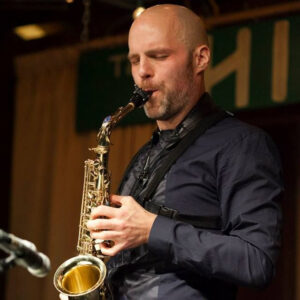
We at Sequenza 21 are saddened to share that Ryan Muncy, saxophonist, curator, and administrator for the International Contemporary Ensemble, has passed away. Ryan was formidable in all of the aforementioned roles. Moreover, he was a much-admired and beloved person; a bright light in the new music community.
Our condolences go out to all of Ryan’s friends and family, in particular to his community at International Contemporary Ensemble. You may read more about Ryan from the ensemble here.
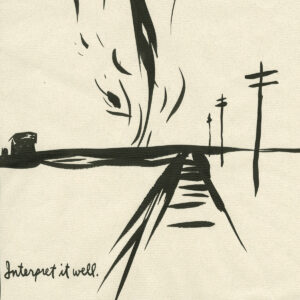
Ches Smith
Interpret it Well
Ches Smith, percussion and electronics; Bill Frisell, guitar; Mat Maneri, viola; Craig Taborn, piano
Pyroclastic Records
Percussionist Ches Smith was previously working in a trio with violist Mat Maneri and pianist Craig Taborn. In 2018, guitarist Bill Frisell heard them live and wanted in. The resulting quartet had to deal with the vicissitudes of the pandemic; their 2020 sessions weren’t released until 2022. Every eighth note is worth the wait.
Smith plays drums and non-pitched percussion. He is also a talented vibraphonist. It makes a big difference that a bass player isn’t part of the proceedings. Taborn, Frisell, and Maneri sometimes emphasize a bass line to fill in for this absence. For the most part, the texture they inhabit doesn’t imitate a classic quartet, instead creating its own, inimitable thing. Interpret it Well is named after the 1987 drawing by Raymond Pettibon that appears on the recording’s cover. The title track employs multiple rhythmic layers, with Taborn creating a steady pulse while the others polyrhythmically depart from it. There are searching solos from Frisell and Maneri and Smith creates a rollicking groove at the drum kit. Another of the extended cuts on the recording, “Mixed Metaphor,” features a long instrumental introduction by Frisell, with other instruments gradually entering from the background to join him. Taborn and Maneri each take solo turns, the pianist creating intricate textures while the violist plays with particularly fiery enthusiasm. Smith urges them on with a strong backbeat.
“Clear Major,” begins with Smith on vibraphone alongside the rest of the quartet, all playing just as the title suggests. Things get thornier as they progress, with the infiltration of sinuous chromatic lines played by Frisell and Maneri, clusters forcefully played by Taborn, and fast triplet percussion fills by Smith. The mid-section moves towards bluesier gestures, with Taborn playing seventh chords and Maneri inflecting his own grooves with trademark microtonality. Frisell gets in on the fun by dovetailing Maneri’s riffs in the same register. The texture dissolves into arpeggiations and terse rhythmic interjections, once again outlining the home key with greater clarity, with Taborn repeating an impressionist harmony over and over. They hang out in this aphoristic atmosphere for a good portion of the piece’s second half. There is a long fade that ends mirroring the beginning’s tonal ambience.
“I Need More” uses a tune based on the spoken rhythm of the title, an old-fashioned technique that is deployed in anything but an old-fashioned sound world. That said, there is a thread between the playing here and more traditional – say post-bop- gestures. It is fascinating to hear how the quartet is able to encompass this change with such subtlety and skill. The climax teases going off the rails only to reassert the tune in unison riffs and end the piece with interlocking ostinatos.
“Morbid” is more chamber music than jazz, with a modal and mysterious sound world that shares more than passing references to Arnold Schoenberg and George Crumb. That “Morbid” is spontaneous, instead the careful composition of its influences, makes the expressionist result all the more stirring.
Two short pieces begin and end the recording. Taborn and Frisell create a loping groove on “Trapped” that is punctuated by repeated chiming from vibes and Maneri sneaks in with a few repeated gestures. Like an unwinding music box, the piece comes apart at the end. On “Deppart,” there is instead a surface that takes time to cohere, almost like the clock winding up here into another corruscated set of repetitions.
Interpret it Well is one of the finest creative music releases thus far in 2022. Look for it on many year-end lists.
-Christian Carey
